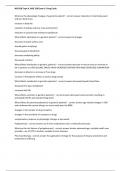Samenvatting
Summary Gehele toetsmatrijs LKT uitgewerkt (deel 2)
- Instelling
- Hogeschool Arnhem En Nijmegen (HAN)
Landelijke kennis toets (LKT). (deel2) De toetsmatrijs voor LKT 2015/2016 geheel uitgewerkt in 80 pagina's. Met hierin o.a. de geschiedenis, ontstaan, bevolking, gewoontes, belangrijke gebeurtenissen, belangrijke personen en oorlogsposities van de Engelstalige landen; Engeland, schotland, Ireland, ...
[Meer zien]













